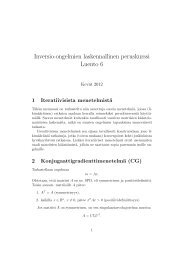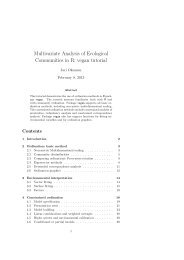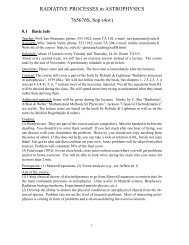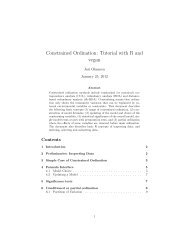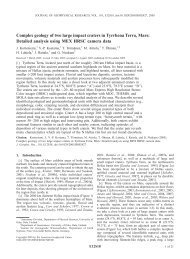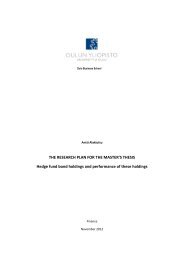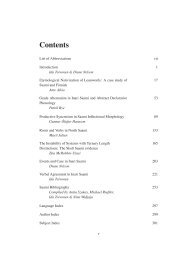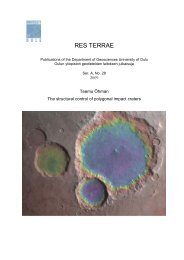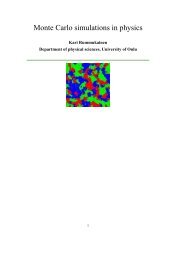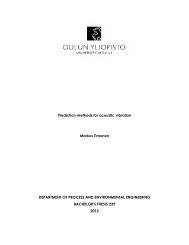Juha Köykkä - Oulu
Juha Köykkä - Oulu
Juha Köykkä - Oulu
- TAGS
- juha
- oulu
- cc.oulu.fi
Create successful ePaper yourself
Turn your PDF publications into a flip-book with our unique Google optimized e-Paper software.
Res Terrae, Ser. A 32, J. <strong>Köykkä</strong>, Sedimentology of the Mesoproterozoic Telemark basin-fills, South Norway: implications for<br />
sedimentation processes, depositional environments and tectonic evolution<br />
tal growth processes were closely associated with oceanic terranes followed by passive<br />
continental margins and voluminous continental flood basalts. Oceanic terranes such<br />
as submarine plateaux or island arcs may have been important building blocks for<br />
crustal growth and continents as they collide and accrete to continental margins. Fur-<br />
ther regional peaks of crustal growth occurred ca. 2.5–1.8 Ga, which indicate possible<br />
tectonically active periods. The continental crust formation was related to mantle<br />
plume events and plate tectonic subduction processes. Although there have been differ-<br />
ing opinions, Nutman et al. (2002) suggested that tectonic processes, which were<br />
mostly related to volcanic arc settings, were operating already at ca. 3.8 Ga.<br />
The evolution of the Precambrian paleo-atmospheric and paleo-hydrospheric com-<br />
positions are mainly based on two different models (Eriksson et al., 2009 and refer-<br />
ences therein): (i) a model that assumes an early reducing atmosphere, a minor oxygen<br />
rise at 3.0–2.8 Ga, and a major oxygen rise at 2.0 Ga; and (ii) a model that assumes a<br />
single rise of oxygen in the atmosphere and oxygenic oceans soon after 4.0 Ga. Recent<br />
studies by Eriksson et al., (2009) assume that the “great oxidation event” at 2.3 Ga<br />
may have been gradational and even diachronous across the Earth’s cratons at that<br />
time. Oceanic growth was concurrent with atmospheric development, and at ca. 4.0<br />
Ga, 90 % of the current oceanic volume was achieved. Oceanic water depths during<br />
that time were probably abyssal, with an absence of biogenic planktonic sedimenta-<br />
tion. The formation of ironstones (IF and BIF) during the Paleoproterozoic-<br />
Mesoproterozoic (peaks ca. 3.8, 2.5, and 1.8 Ga) was likely related to iron-rich waters<br />
as a result of fumarolic origin beneath the pycnocline and oxygen released by photo-<br />
synthetic cyanobacteria above the pycnocline. The lack of major iron formation dur-<br />
ing the Mesoproterozoic was likely caused by increased oceanic oxidation due to in-<br />
creasing organism populations and photosynthesis.<br />
During the early evolution of Earth, the atmosphere was mainly composed of CO2,<br />
N2, CH4, and possibly small amounts of CO, H2, H2O and reduced sulphur gases (e.g.,<br />
Des Marais, 1994). The elevated green-house gas levels in Earth’s early paleo-<br />
atmosphere raised weathering rates, and geothermal activity, and acidic waters led to<br />
the aggressive breakdown of rocks, which probably affected the deposition of first-<br />
cycle quartz arenites (Corcoran and Mueller, 2004). After 2.0 Ga, the red beds became<br />
16



